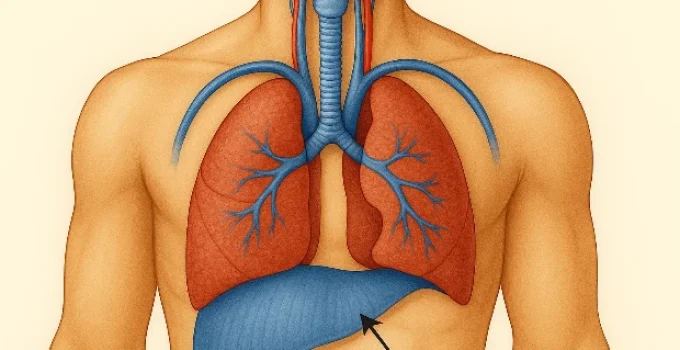How Does the Diaphragm Work?
When you think of muscles, you might picture your arms or legs. But one of the most important muscles in your body is hidden beneath your lungs. It’s called the diaphragm, and it plays a powerful role in helping you breathe every moment of the day—even while you sleep!
Let’s take a closer look at how this flat, dome-shaped muscle makes every breath possible.
🔍Dive Deeper
- What Is the Diaphragm?
- Where Is the Diaphragm Located?
- How the Diaphragm Helps You Breathe In
- How the Diaphragm Helps You Breathe Out
- The Diaphragm and Other Body Functions
- 🎯 Final Thoughts
- 📚 References
💪What Is the Diaphragm?
The diaphragm is a skeletal muscle, which means it’s a muscle you can control—but it also works automatically without you thinking about it. It forms a strong barrier between your chest cavity (where your heart and lungs are) and your abdominal cavity (where your stomach, liver, and intestines are).
The diaphragm is shaped like a parachute or dome when relaxed and becomes flat when it contracts.
🤔 Did you know? The diaphragm is involved in about 80% of your breathing! [1]
🍤Where Is the Diaphragm Located?
The diaphragm sits underneath your lungs and above your liver and stomach. When it moves, it changes the shape of your chest, which is how air enters and exits the lungs.
Here’s a simple visual table:
| Location | Organs Above | Organs Below |
|---|---|---|
| Middle of the torso | Lungs, heart | Liver, stomach, intestines |
📏 Interesting fact: The diaphragm is about 1/4 inch thick and stretches across your entire body—left to right. [2]
🫁How the Diaphragm Helps You Breathe In
When you breathe in (inhalation), the diaphragm contracts and pulls downward. This creates more space in your chest and lowers the pressure inside your lungs. Air rushes in to fill this space, entering through your nose or mouth and traveling to your lungs.
This process happens:
- Automatically (without thinking)
- Or on purpose (when you take a deep breath)
| Step | What the Diaphragm Does |
|---|---|
| Start of inhalation | Contracts and flattens |
| Chest cavity | Expands to make room for lungs |
| Air pressure | Drops, pulling air into the lungs |
📊 Stat check: The diaphragm contracts about 12 to 20 times per minute in a resting adult—and even more when you’re exercising! [3]
🌬️How the Diaphragm Helps You Breathe Out
Breathing out, or exhalation, is mostly a passive process. When the diaphragm relaxes, it returns to its dome shape and pushes up against the lungs. This reduces space in the chest, increasing pressure and pushing air out.
If you’re breathing heavily (like during exercise), your abdominal muscles help push air out faster by working with the diaphragm.
🌬️ Cool fact: Even when you whisper, your diaphragm is still doing the work to move air out of your lungs! [4]
🗣️The Diaphragm and Other Body Functions
Besides breathing, the diaphragm also helps with:
- Coughing: A strong contraction helps force air out quickly.
- Sneezing: Works with other muscles to clear the airways.
- Vomiting and burping: The diaphragm contracts to build pressure in the abdomen.
- Talking and singing: Controls airflow and pressure to help produce sound.
And yes, it even plays a role when you get the hiccups! Hiccups happen when the diaphragm suddenly contracts, causing a quick breath in that’s cut off by the closing of the vocal cords.
🎤 Fun fact: Singers train their diaphragm to control long breaths for holding notes or singing loudly! [5]
🎯 Final Thoughts
How does the diaphragm work? It is the unsung hero of your respiratory system. It works silently and powerfully beneath your lungs, pulling in fresh oxygen and helping remove carbon dioxide every minute of the day. Whether you’re breathing quietly or shouting in gym class, your diaphragm is in action—helping you live, move, and even speak. Next time you take a deep breath, give a little thanks to this mighty muscle.
📚 References
- American Lung Association. “How Breathing Works.”
https://www.lung.org/lung-health-diseases/how-lungs-work - Cleveland Clinic. “Diaphragm Function and Disorders.”
https://my.clevelandclinic.org/health/body/21766-diaphragm - National Institutes of Health. “Respiratory Rate and Control of Breathing.”
https://www.ncbi.nlm.nih.gov/books/NBK470379/ - Khan Academy. “How the Lungs and Diaphragm Work Together.”
https://www.khanacademy.org/science/biology/human-biology/respiratory-system/a/structure-of-the-respiratory-system - Smithsonian Magazine. “Why Do We Get Hiccups?”
https://www.smithsonianmag.com/smart-news/why-do-we-get-hiccups-180978938/
📌Learn More About the Respiratory System
- What Are the Main Organs of the Respiratory System?
- How Do We Breathe?
- How Does the Diaphragm Work?
- How Do the Lungs Work?
- Why Do We Cough?
- Why Do We Hiccup?
